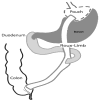Gastric bypass increases ethanol and water consumption in diet-induced obese rats
- PMID: 22976430
- PMCID: PMC3615544
- DOI: 10.1007/s11695-012-0749-2
Gastric bypass increases ethanol and water consumption in diet-induced obese rats
Erratum in
- Obes Surg. 2013 Mar;23(3):424
Abstract
Background: Roux-en-Y gastric bypass surgery (RYGB) is an effective treatment for morbid obesity. Increased alcohol abuse after RYGB resulted in recommendations to exclude patients with alcohol abuse histories from RYGB. The purpose of our study was to examine the effects of a RYGB on ethanol intake in diet-induced obese rats (high-fat diet).
Methods: The animals underwent RYGB and were habituated along with their sham-operated obese controls and with lean rats to increasing concentrations of ethanol in a two-bottle choice paradigm.
Results: RYGB rats' daily consumption of ethanol averaged 2 g/kg at 2% habituation and 3.8 g/kg at 4% habituation, twice as much as sham-operated obese controls and 50% more than normal-diet lean controls. Obese controls drank on average 1 g/kg of ethanol (2 and 4%), significantly less (50%) than lean controls did. RYGB rats when given higher ethanol concentrations (6 and 8%) or no ethanol drank significantly more water than lean and obese controls did (66 and 100%, respectively), and their enhanced total fluid intake was associated with increased food intake, which was significantly higher than in lean (66% more calories; food + alcohol) and obese controls (44% more calories). The lower alcohol intake in the obese controls than in the lean rats suggests that obesity may interfere with alcohol's rewarding effects and RYGB may remove this protective effect.
Conclusions: The overall enhancement of consummatory behaviors (both ethanol and water) suggests that RYGB may facilitate alcohol consumption, which in vulnerable individuals could lead to abuse and addiction.
Conflict of interest statement
Conflict of Interest:
Panayotis K. Thanos, Ph.D, Mike Subrize, B.S., Foteini Delis, Ph.D, Robert N. Cooney M.D., Derek Culnan, M.D., Mingjie Sun, Ph.D., Gene-Jack Wang, M.D., Nora D. Volkow, M.D. and Andras Hajnal, M.D., Ph.D. do not have any conflict of interest to disclose. This work was supported by the NIAAA (AA 11034 & AA07574, AA07611) DK080899 (AH).
Figures




References
-
- Andrés M, et al. Roux-en-Y gastric bypass: major complications. Abdominal Imaging. 2007;32(5):613–618. - PubMed
-
- Sugerman H, et al. Gastric bypass for treating severe obesity. Am J Clin Nutr. 1992;55(2):560S–566. - PubMed
-
- Marcus MD, Kalarchian MA, Courcoulas AP. Psychiatric Evaluation and Follow-Up of Bariatric Surgery Patients. Am J Psychiatry. 2009;166(3):285–291. - PubMed
-
- Steele K, et al. Alterations of Central Dopamine Receptors Before and After Gastric Bypass Surgery. Obesity Surgery. 2010;20(3):369–374. - PubMed
Publication types
MeSH terms
Substances
Grants and funding
LinkOut - more resources
Full Text Sources
Medical
Research Materials

